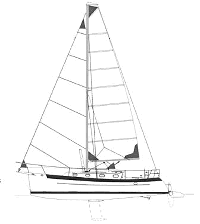Seaward Eagle 32
Coastal cruiserr
I saw this boat at the Annapolis Boat Show. You should really go to that show. I don't know of any other show that gets the sheer numbers of different models collected in one extended marina. I thought this was a handsome boat with a perky, near-plumb stem, nice accenting rubrail and well-sculpted deck structures. What I don't like about his design is the way the sheer spring has been exaggerated aft. This is a great example of why you need to think of these lines in three dimensions. The sailplan shows this strong sheerline, and it looks just fine. But in the water, it appears to my eye that there is some conflict with the sheer's low point and the distribution of beam. The kick in the sheer aft is just too exaggerated for my eye. Still, it's good to see a designer with the chutzpa to put a healthy spring in the sheer. It certainly gives this boat a distinct personality, and nit-picking aside I like this boat. The sheer is even further accentuated by the integral extension of the GRP bowsprit. The design work was done by the company president, Nick Hake. The new model is a development of the company's fixed-keel Eagle, which was introduced in 1988.
This is a shapely, dinghylike hull with a hard knuckle at the forefoot and the deepest part of the canoe body well forward. The fin and bulb keel fully retract so that only the bulb is visible, which reduces the draft from 6 feet, 6 inches to 20 inches. The keel is raised with an electric winch operated from the cockpit. If the winch fails you can use the mainsheet to raise the keel. The cleverly designed outboard rudder kicks up. Rudder and propeller are well above the low point of the retracted keel. Displacement is 8,300 pounds with a 30 percent ballast-to-displacement ratio. The point of maximum beam is very far aft in this design. Using the typical 10-station breakdown of hull shapes, most boats show max beam around station 6. In this case, however, it has been pushed aft to around station 8. The D/L is 129.
Like many small production cruising boats, this model is built with a molded GRP liner. The Seaward Eagle's interior is very nicely detailed with laminated teak joiner accents. The layout has been carefully balanced to provide a good-sized dinette to port with small seats to starboard in the main cabin. There is a double quarter-berth to port and a V-berth makes another double. The head has a shower stall and this is quite unusual on a 32-footer. The lifting-keel trunk is neatly worked into this layout, so its impact is negligible, if even noticeable.
The rig features a fathead mainsail with extended headboard to maximize the main area while keeping the overall mast height minimized. I suspect this may have been done to help with the trailering aspect of the design. A long crane at the masthead pulls the backstay aft so it clears the roach of the main. SA/D is 17.95 and that should be plenty to give the Eagle good speed in all conditions. The mast is lowered and raised using the exposed upper keel arm as a gin pole. I wondered what that strange stainless tubing feature shown in the photos was on the stern until I realized it's a crutch to hold the mast when it's lowered for trailering.
On deck the Eagle is detailed in yachtlike fashion, and this boat has a very capable look to it. The transom is open to allow direct access to the rudder lifting mechanism. There is 65 gallons of water tankage, 24 gallons of fuel and 30 gallons of holding. The auxiliary is a 28-horsepower Yanmar.

Comments